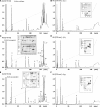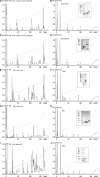Antivenomic assessment of the immunological reactivity of EchiTAb-Plus-ICP, an antivenom for the treatment of snakebite envenoming in sub-Saharan Africa
- PMID: 20519622
- PMCID: PMC2877433
- DOI: 10.4269/ajtmh.2010.09-0733
Antivenomic assessment of the immunological reactivity of EchiTAb-Plus-ICP, an antivenom for the treatment of snakebite envenoming in sub-Saharan Africa
Abstract
The immunoreactivity of EchiTAb-Plus-ICP, an antivenom developed for the treatment of snakebite envenoming in sub-Saharan Africa, to venoms of seven Echis and Bitis species, was assessed by "antivenomics." This proteomic approach is based on the ability of an antivenom to immunodeplete homologous or heterologous venom proteins. Our results show an extensive cross-reactivity of this antivenom against all Echis and Bitis venoms studied, as revealed by the complete immunodepletion of the majority of venom components, including metalloproteinases, serine proteinases, C-type lectin-like proteins, some phospholipases A(2) and L-amino acid oxidase. However, some phospholipases A(2), disintegrins and proteinase inhibitors were immunodepleted to only a partial extent. These results support the hypothesis that immunizing horses with a mixture of the venoms of Echis ocellatus, Bitis arietans, and Naja nigricollis generates antibodies capable of recognizing the majority of components of medically-relevant homologous and heterologous viperid venoms of the genera Bitis and Echis from sub-Saharan Africa.
Figures


Similar articles
-
Preclinical assessment of the efficacy of a new antivenom (EchiTAb-Plus-ICP) for the treatment of viper envenoming in sub-Saharan Africa.Toxicon. 2010 Feb-Mar;55(2-3):369-74. doi: 10.1016/j.toxicon.2009.08.010. Epub 2009 Aug 21. Toxicon. 2010. PMID: 19699756
-
Pre-clinical assays predict pan-African Echis viper efficacy for a species-specific antivenom.PLoS Negl Trop Dis. 2010 Oct 26;4(10):e851. doi: 10.1371/journal.pntd.0000851. PLoS Negl Trop Dis. 2010. PMID: 21049058 Free PMC article.
-
Effect of geographical variation of Echis ocellatus, Naja nigricollis and Bitis arietans venoms on their neutralization by homologous and heterologous antivenoms.Toxicon. 2015 Dec 15;108:80-3. doi: 10.1016/j.toxicon.2015.10.001. Epub 2015 Oct 9. Toxicon. 2015. PMID: 26450770
-
Immunological profile of antivenoms: preclinical analysis of the efficacy of a polyspecific antivenom through antivenomics and neutralization assays.J Proteomics. 2014 Jun 13;105:340-50. doi: 10.1016/j.jprot.2014.02.021. Epub 2014 Feb 28. J Proteomics. 2014. PMID: 24583507 Review.
-
Antivenom therapy of carpet viper (Echis ocellatus) envenoming: effectiveness and strategies for delivery in West Africa.Toxicon. 2013 Jul;69:82-9. doi: 10.1016/j.toxicon.2013.01.002. Epub 2013 Jan 20. Toxicon. 2013. PMID: 23339853 Review.
Cited by
-
Virus-like particles displaying conserved toxin epitopes stimulate polyspecific, murine antibody responses capable of snake venom recognition.Sci Rep. 2022 Jul 5;12(1):11328. doi: 10.1038/s41598-022-13376-x. Sci Rep. 2022. PMID: 35790745 Free PMC article.
-
Third Generation Antivenomics: Pushing the Limits of the In Vitro Preclinical Assessment of Antivenoms.Toxins (Basel). 2017 May 10;9(5):158. doi: 10.3390/toxins9050158. Toxins (Basel). 2017. PMID: 28489039 Free PMC article.
-
Consequences of neglect: analysis of the sub-Saharan African snake antivenom market and the global context.PLoS Negl Trop Dis. 2012;6(6):e1670. doi: 10.1371/journal.pntd.0001670. Epub 2012 Jun 5. PLoS Negl Trop Dis. 2012. PMID: 22679521 Free PMC article.
-
Priority Actions and Progress to Substantially and Sustainably Reduce the Mortality, Morbidity and Socioeconomic Burden of Tropical Snakebite.Toxins (Basel). 2016 Nov 24;8(12):351. doi: 10.3390/toxins8120351. Toxins (Basel). 2016. PMID: 27886134 Free PMC article.
-
Immunorecognition and Neutralization of Crotalus durissus cumanensis Venom by a Commercial Antivenom Produced in Colombia.Toxins (Basel). 2022 Mar 25;14(4):235. doi: 10.3390/toxins14040235. Toxins (Basel). 2022. PMID: 35448844 Free PMC article.
References
-
- Snow RW, Bronzan R, Roques T, Nyamawi C, Murphy S, Marsh K. The prevalence and morbidity of snake bite and treatment-seeking behaviour among a rural Kenyan population. Ann Trop Med Parasitol. 1994;88:665–671. - PubMed
-
- Warrell DA. In: Handbook of Clinical Toxicology of Animal Venoms and Poisons. Meier J, White J, editors. Boca Raton, FL: CRC Press; 1995. pp. 433–492. (Clinical toxicology of snakebite in Africa and the Middle East/Arabian peninsula).
-
- Chippaux JP. In: Perspectives in Molecular Toxinology. Ménez A, editor. England: John Wiley; 2002. pp. 457–472. (The treatment of snake bites: analysis of requirements and assessment of therapeutic efficacy in tropical Africa).
Publication types
MeSH terms
Substances
LinkOut - more resources
Full Text Sources

